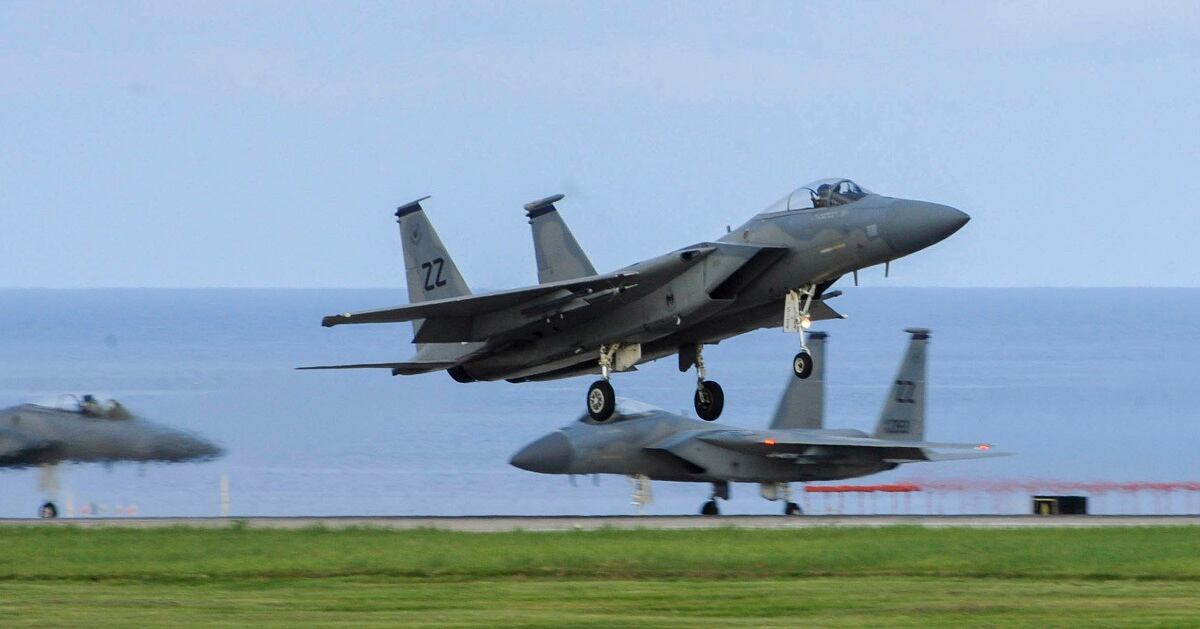Shockwaves swept the Washington security establishment this fall upon hearing the U.S. Air Force is going to retire F-15C/Ds based at Kadena Air Force Base in Okinawa, Japan, without a direct replacement, instead reverting to a rotational presence. Members of Congress even threatened legislation to block the move. Bottom line: This development should not surprise anyone.
Service leaders have telegraphed this eventuality for years given the dynamics of an aging aircraft inventory and too few dollars to buy enough replacements. The hard fact is that if you want air power, you need enough airplanes and trained crews; that takes resources. If those investments are not more forthcoming, developments like the F-15C/D withdrawal from Kadena are merely the tip of the iceberg.
People are right to be concerned about the removal of the F-15C/Ds from Kadena. Not only are the aircraft a highly visible sign of America’s resolve in the Pacific theater — both reassuring allies and deterring adversaries — but the aircraft also execute the air superiority mission. This counts for a lot when defending our forces in the region and checking adversarial aggression.
Commanders implicitly understand the value of fighter aircraft, and that is why they are always looking for more. In my last assignment in uniform, as the deputy chief of staff for operations, it was my job to meet as many combatant command requests for Air Force aircraft as possible, including fighters. We were always running out of planes; there were never enough, and this was during peacetime. A major theater conflict will project overwhelming demands that the Air Force enterprise is not sized to meet, especially when things like aircraft losses in combat enter the equation.
This is exactly why in 2018 Secretary of the Air Force Heather Wilson warned: “The Air Force is too small for what the nation expects of us.” This led to a planning construct that outlined the need to grow the service to 386 operational squadrons, which included a boost for fighters. The commander of Air Combat Command, Gen. Mark Kelly, reaffirmed in a recent speech that this demand signal still exists four years later: “It’s like a bill that comes to your house … for 60 multirole fighter squadrons.”
The problem is that the nation has asked the Air Force to stretch its aircraft modernization resources too far for too long. The Air Force’s budget has been less than those of the Navy and Army for the last 30 years in a row. In fact, the Army received about $1.3 trillion more than the Air Force between 2002-2021 after removing pass-through. Lacking cash, the Air Force essentially began to cannibalize itself to try and buy new capabilities through “divesting to invest.” However, as anyone knows, getting rid of a used car will never manifest the level of resources required to buy a new one. So, absent enough resources, aircraft inventories grew smaller, and crews flew even harder, and maintenance folks gave their all trying to make up the difference.
Such herculean efforts can only work so long before burning out the force, especially with demand for air power surging. To this point, when the Air Force fought Desert Storm in 1991, it had 4,556 fighters. Today, it has less than half that amount, at 2,221. The world did not get more peaceful in that window of time. Of these remaining planes, only a small percentage, like the F-22 and F-35, are modern types imbued with the capabilities necessary to fly, fight and survive against high-end, modern threats. Crews — both pilots and maintainers — are stretched similarly thin.
Our adversaries continue to drive the demand signal upward, so it is important to provide the Air Force with the resources to buy the aircraft it needs to meet mission demands at an acceptable, sustainable level of risk. That simply has not occurred in recent years. One glaring example involves the Air Force’s newest fighter, the F-35. Original projections for this fleet saw the Air Force buying over 100 F-35s annually at this juncture. Instead, the fiscal 2023 National Defense Authorization Act, which has yet to pass, saw the Air Force’s F-35 procurement drop to a mere 38. As we go into FY24 and beyond, we need to acquire 72 fighters per year to modernize the force and boost capacity to 60 squadrons. This will also allow older aircraft to retire and see manpower and resources tied to them transition to supporting more relevant, modern types.
The alternative is what the Air Force is doing at Kadena. Geriatric aircraft like the F-15C/D literally run out of service life and must retire. There are not enough new types to backfill them, so remaining aircraft are kluged together on a rotational basis to fill the gap. It is a death spiral, asking aircraft and crews to do more with less until they simply collapse. That is why F-22s were deployed from the Pacific to meet demand in Europe this summer, and you’ll likely see European-based fighters head to cover rotations at Kadena. This is what happens when the service tries to add two and two to get five.
America’s Air Force needs to regain altitude and airspeed. This requires buying more modern aircraft to meet the demand signal. Otherwise, we crash. And given all the missions the Air Force underwrites, the ultimate effects of this problem extend to the entire joint force. It is no secret this will cost more money, but it is far more affordable than losing the next conflict. As ACC Commander Gen. Kelly explains: “The only thing more expensive than a first rate Air Force is a second rate Air Force.”
Retired U.S. Air Force Lt. Gen. Joseph Guastella is a senior fellow with the Mitchell Institute for Aerospace Studies. He most recently served as deputy chief of staff for operations at Headquarters Air Force.





